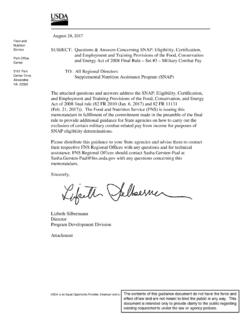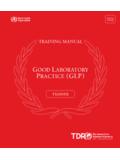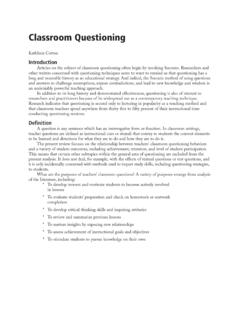Transcription of UNITED STATE DEPARTMENT OF AGRICULTURE FOOD AND …
1 UNITED STATE DEPARTMENT OF AGRICULTURE . FOOD AND NUTRITION SERVICE. SUPPLEMENTAL NUTRITION ASSISTANCE PROGRAM. 2010. 2013. E MPLOYMEN T A N D T RA IN IN G T OO LKIT. A ATOOLKIT. TOOLKITTOFOR. HELP. DYNAMIC. STATES CREATE, EMPLOYMENT. IMPLEMENT ANDAND. training . MANAGEPDROGRAMS. YNAMIC. E&T PROGRAMS. Introduction T ABLE OF C ONTENTS. Introduction .. 4. Use of this 4. Acknowledgements .. 5. E&T Basics .. 7. Overview .. 7. SNAP Work Requirements .. 9. E&T 13. Essentials of an E&T Program .. 16. An Overview of the E&T Program .. 16. Essential characteristics of a SNAP E&T Program .. 16. E&T Components .. 20. E&T Options Serving Volunteers .. 26. Partnerships & Third-Party Reimbursements .. 32. Work Supplementation Programs .. 52. Appendix A: Education Components In-depth .. 55. Appendix B: Allowable E&T Participant Reimbursements .. 48. Appendix C: Cost Principles .. 50. Appendix D: Frequently Asked Questions .. 61. Appendix E: STATE -by- STATE information.
2 85. Further Resources .. 87. SNAP E&T Toolkit Page |2. Introduction INTRODUCTION. SNAP E&T Toolkit Page |3. Introduction I NTRODUCTION. The purpose of this toolkit is to provide STATE agencies with the know-how and resources to plan and implement Employment and training (E&T) Programs under the Supplemental Nutrition Assistance Program (SNAP, formerly called the Food Stamp Program). In 1987, Congress established the Food Stamp Employment and training Program to assist able-bodied food stamp recipients in obtaining employment. From its conception, the purpose of the E&T. Program has been to help SNAP households gain skills, training , work, or experience that will increase self-sufficiency. There have, however, been changes in the population served by SNAP. The recent economic recession has resulted in a vast number of newly unemployed individuals who are turning to the national social safety net for nutrition assistance and work support.
3 While some SNAP. clients need assistance with job search training and basic skills, other clients would benefit more from vocational training that would enhance their ability to obtain regular employment. This toolkit can assist STATE agencies in developing a dynamic E&T program to meet this wide range of needs. The Food and Nutrition Act (the Act) of 2008 gives STATE agencies a great deal of flexibility in designing their E&T program. STATE E&T programs must include at least one of the following: 1). A job search program; 2) a job search training program, consisting of activities such as job skills assessment, job clubs, etc.; 3) workfare programs; 4) work experience or training ; 5) STATE , local or Workforce Investment Act (WIA) work programs; 6) education programs such as Basic Adult Education, GED preparation, and English as a Second Language classes; and 7) self-employment. STATE agencies also have discretion the geographic coverage of their E&T programs.
4 The great range of options enables variety across States, but it can also be confusing. Section 1 of this toolkit reviews the basics of SNAP work requirements and the E&T program. Section 2 covers essentials of an E&T component and goes into depth on specific E&T components. Section 3 of this toolkit will focus on STATE E&T options, such as targeting voluntary participants and work supplementation. U SE OF THIS TOOLKIT. This toolkit is designed to help STATE agencies create new SNAP E&T programs. Some of the material in this toolkit is tied directly to the Act and SNAP regulations. Other material, such as checklists, STATE -specific examples and recommendations are not Federal requirements and are meant to be resources that may help States better meet the employment and training needs of SNAP E&T Toolkit Page |4. Introduction low income households. This toolkit is a living document, posted on the E&T PartnerWeb Community. Links within the document lead to other sections of the document itself or helpful Internet resources.
5 As a living document, this toolkit will be updated periodically to reflect new information on best practices, updated resources and changes to Federal legislation. If you have comments or questions on this toolkit, you can contact your Regional Office for more information. FNS. encourages States to share tools that can be included in future updates to this toolkit, such as sample contracts, evaluation forms, or proposals that will improve the efficiency and effectiveness of SNAP E&T programs. A CKNOWLEDGEMENTS. FNS would like to acknowledge and thank the staff, STATE partners and non-government organizations that reviewed various drafts of this document. Thank you for your thoughtful review and helpful comments. SNAP E&T Toolkit Page |5. SECTION 1: E&T BASICS. E&T 101. SNAP E&T Toolkit Page |6. E&T Basics E&T B ASICS. O VERVIEW. The Food and Nutrition Act (the Act) of 2008 provides that the purpose of the Employment and training (E&T) program is to provide Supplemental Nutrition Assistance Program (SNAP).
6 Participants opportunities to gain skills, training or experience that will improve their employment prospects and reduce their reliance on SNAP benefits. Additionally, the E&T. program offers a way to allow SNAP recipients to meet work requirements stipulated in the Act. The Act mandates that all nonexempt SNAP recipients register for work. STATE agencies have the authority to determine which local areas will operate a SNAP E&T Program and, based on their own criteria, whether or not it is appropriate to refer these individuals to the Program. The Act and SNAP regulations provide STATE agencies with a great deal of flexibility in designing the employment and training services they wish to offer SNAP recipients. Each STATE agency Federal funding for must develop and operate an E&T program that consists of one or E&T Programs is more of the employment and/or training components covered in contingent upon Section 2 of this toolkit.
7 The program must be approved by the approval of a STATE Food and Nutrition Service (FNS) through a STATE E&T Plan1. A E&T Plan by FNS. and the availability review of 15 States by the Government Accountability Office of Federal funds. (GAO) in 2003 found that SNAP E&T participants were generally Detailed information hard to employ because of a lack of education, a limited on the STATE E&T. employment history, and because some SNAP recipients subject to Plan can be found in the E&T Handbook. work requirements are prone to substance abuse or homelessness. A STATE should tailor its E&T program to meet the needs of its participants and the local economy, thereby increasing the likelihood of recipients gaining self-sufficiency. FNS has observed that the demand for E&T services increases during a weak economy as more SNAP clients are underemployed or unemployed and need additional training or skills to increase their employability. Experts predict that SNAP participation will remain high even as the economy improves before eventually leveling off.
8 Now, more than ever, SNAP E&T is 1. The STATE E&T Program Handbook can be found at: SNAP E&T Toolkit Page |7. E&T Basics important to the livelihood and self-sufficiency of clients and also the STATE and local economy. E&T programs should be designed to meet the needs of an ever-changing local job market. The box below shows that most States offer job search through their E&T program. In a healthy economy, job search may be effective at helping work-ready SNAP clients find employment. In a weaker economy, however, job search may not be as effective. This toolkit will provide ideas, guidelines and tools to help STATE agencies tailor the SNAP E&T programs for their STATE . % OF STATES OFFERING SPECIFIC E&T. COMPONENTS (FY2012). 68% Independent job search 66% Job search training (job clubs, resume workshops, etc). 32% Workfare/work experience 17% Work placements (on-the-job training , apprenticeships). 66% Education (basic education, ESL, GED, vocational education).
9 9% Self-employment 36% Job retention services For components by STATE , please see Appendix E. SNAP E&T Toolkit Page |8. E&T Basics SNAP W ORK R EQUIREMENTS. As a condition of SNAP eligibility, individuals must comply with SNAP work requirements unless otherwise exempt. W O R K R E Q U I R E M E N T S include: registering for work at time of application and every 12 months thereafter; participating in a E&T program if assigned by the STATE agency;. participating in a workfare program if assigned by the STATE agency; providing information on employment status; reporting to an employer if referred by the STATE agency; accepting a bona fide offer of suitable employment; and not voluntarily quitting a job without good cause or reducing work hours to less than 30 hours per week. As illustrated in the graph at right, only a small percentage of SNAP Recipients Subject to and Exempt SNAP clients are actually subject from Work Requirements, Fiscal Year 2011.
10 To work requirements. The majority of SNAP clients are exempt due to age, ability and Over age availability. 15% of all SNAP 59. 9%. participants in FY 2011 were Working age adults subject to the work exempt from Under age work requirements. About 54% of 18 requirements SNAP clients were exempt due to 45% 31%. age. Another 31% of clients were working age adults but exempt Adults because of a disability, caring for subject to work a dependent under the age of 6 requirements 15%. or because they were already working at least 30 hours a Source: DEPARTMENT of AGRICULTURE , Food and Nutrition Service, Office of Research week. and Analysis, Characteristics of Supplemental Nutrition Assistance Program Households: Fiscal Year 2011, by Mark Strayer, Esa Eslami, and Joshua Leftin The terms work registrants . and mandatory E&T participants are often confused or used interchangeably. However, it is important that STATE agencies understand the difference between these two terms, as their meanings are very distinct and have corresponding provisions in the SNAP regulations.















